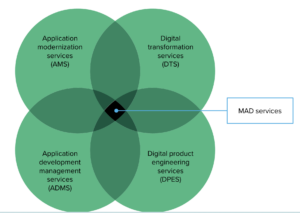Modern Application Development Services Defined
Clients want more autonomy to better control their own innovation and development capabilities to build modern and up-to-date custom applications. In Forrester’s Priorities Survey, 2024, 64% of business and technology professionals said that bringing more development in-house would be a high or critical priority for their IT organization over the next 12 months. Application development leaders want more collaboration, cocreation, and co-development partnership models with application development service providers. Forrester defines MAD service providers as:
Service providers that work collaboratively with their clients to cocreate custom modern applications and, in parallel, assist them in the transformation and modernization of their software development capabilities and organization.
This figure shows what MAD services are and are not.

Select The Best Partner With The Best MAD Services For Your Needs
We invited about 50 vendors in the market to evaluate which ones are a fit, or a potential it (i.e:, those on the journey of transforming from tactical pre-existing development services towards MAD) and 42 of them made it in this vendor landscape. Some vendors did not make it as they didn’t have sufficient out-of-region presence, although you might take them in consideration in your short list if they are local to you, like Imola Informatica in Europe or Apexcon and West Monroe in the US, or Maverick if you are in the financial services space and in the US. The 42 vendors that made it in the vendor landscape, besides meeting other inclusion criteria, are global with more than 15% revenue in more than one region and implement a comprehensive list of MAD services and have a broad industry recognition.
Here’s How MAD Service Firms Differentiate
Compared to more traditional services companies MAD service vendors focus on the following core business scenarios:
- Project-to-Product transformations
- AI-Infused apps (AIIAs) co-creation
- Custom applications co-cocreation
- Platform engineering operationalization
- AD&D organization/culture transformation
We extended these scenarios with business scenarios such as backend integration and modernisation, GenAI to increase employee productivity, modern measurement metrics and product operating model. MAD vendors must be fully proficient and efficient in delivering Agile and DevSecOps services, leverage low-code no code technologies, which are almost considered a commoditised service by many. Clients also expect vendors to come with strong capabilities for these scenarios, and with extensive in field experience. MAD service companies enhance DevSecOps services with SRE and platform engineering services. The big disruptor in MAD services market is obviously GenAI, which brings custom solutions development to new levels, and introduces new testing practices and tools for testing of AI. At last but not at least they must come with Architecture capabilities to build and deliver AIIAs quickly and continuously.
Some Early Takeaways
While AI and GenAI is on everyone’s roadmap, not all vendors yet offer proficient services or accelerators and are still ramping up, especially when these services have to support large scale MAD deployments. Vendors are investing heavily in ramping up their skills on AI and Generative AI, while are also infusing GenAI and AI in their MAD accelerators (software IP). The impact of AI and GenAI is changing the business model shifting towards more outcome based delivery with a focus on business value.
The big challenge will be that as the MAD market grows, AI matures, and vendors become more proficient and productive, clients expect to inherit those benefits too. You can get a deeper view on MAD market by downloading the report here. The next step in this MAD services research space is the Wave which I just kicked off. So stay tuned to find out the top 10-15 worldwide players and how the stack up against each other. Have a good summer!.







